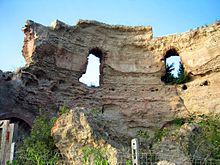- Avernus
-
Avernus was an ancient name for a crater near Cumae (Cuma), Italy, in the Region of Campania west of Naples. It is approximately 3.2 kilometres (2.0 mi) in circumference. Within the crater is Lake Avernus (Lago d'Averno).[1]
Contents
Role in ancient Roman society
Avernus was believed to be the entrance to the underworld, and is portrayed as such in the Aeneid of Virgil. The name comes from the Greek word άορνος, meaning "without birds", because according to tradition, all birds flying over the lake were destined to fall dead.[2] This was likely due to the toxic fumes that mouths of the crater gave off into the atmosphere. In later times, the word was simply an alternate name for the underworld. On the shores of the lake is the grotto of the Cumaean Sybil and the entrance to a long tunnel (Grotta di Cocceio, ca. 800 metres (2,600 ft)) leading toward Cumae, where her sanctuary was located. There are also the remains of temples to Apollo and Jupiter. During the civil war between Octavian and Antony, Agrippa tried to turn the lake into a military port, the Portus Julius. A waterway was dug from Lake Lucrino to Avernus to this end. The port's remains may still be seen under the lake's surface.
Averni
The term Avernus (plural Averni) was also used by ancient naturalists for certain lakes, grottos, and other places which infect the air with poisonous steams or vapors. They were said to be frequent in Hungary on account of the abundance of mines there. The Grotto dei Cani in Italy was a famous example. The most celebrated of these, however, is Lake Avernus.
They were also called mephites. Mephitis was the Roman goddess of noxious vapors, who protects against malaria. The adjective "mephitic" means "foul-smelling" or "malodorous".
See also
- Ploutonion, "grotto of Plouton," a Greek term for a mephitic sanctuary
References
- ^
 Chisholm, Hugh, ed (1911). "Avernus". Encyclopædia Britannica (11th ed.). Cambridge University Press.
Chisholm, Hugh, ed (1911). "Avernus". Encyclopædia Britannica (11th ed.). Cambridge University Press. - ^
 This article incorporates content from the 1728 Cyclopaedia, a publication in the public domain. Article “Averni.”
This article incorporates content from the 1728 Cyclopaedia, a publication in the public domain. Article “Averni.”
Roman mythology and religion Deities Apollo · Bona Dea · Castor and Pollux · Ceres · Cupid · Diana · Dis Pater · Faunus · Genius · Hercules · Janus · Juno · Jupiter · Lares · Liber · Mars · Mercury · Minerva · Orcus · Neptune · Penates · Pluto · Priapus · Proserpina · Quirinus · Saturn · Silvanus · Sol · Venus · Vesta · Vulcan
See also List of Roman deitiesAbstract deities Legendary founders Texts Vergil, Aeneid · Ovid, Metamorphoses and Fasti · Propertius, Elegies Book 4 · Apuleius, Metamorphoses (The Golden Ass)Concepts and practices See also 
This article relating to an Ancient Roman myth or legend is a stub. You can help Wikipedia by expanding it.

